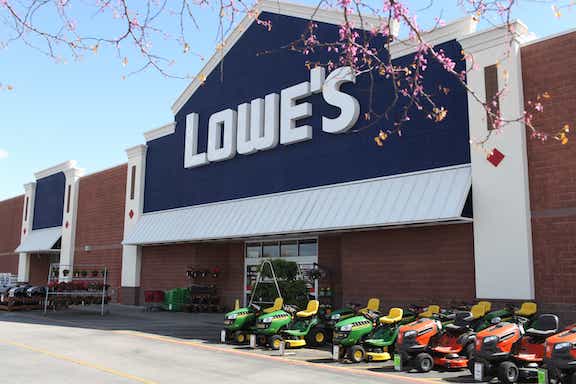Home centers such as Lowe’s may be underestimated in a sector where macroeconomic influences have an effect, but also where some factors may be underappreciated.
In the first quarter ended May 1, Lowe’s posted net earnings of $2.32 billion, or $3.21 per diluted share, versus $1.34 billion, or $1.76 per diluted share, in the year-prior quarter.
Comparable sales increased 25.9% in the quarter year over year with comps in the United States gaining 24.4%.
Net sales were $24.42 billion versus $19.68 billion in the quarter a year prior and operating income was $3.25 billion versus $1.99 billion in the fiscal year earlier.
An analyst estimate from Zacks Investment Research called for earnings of $2.52 per share.
In the aftermath, Lowe’s share price began a decline based on factors particularly in the housing sector, where lumber prices are up and housing construction has been overshadowed by the tight labor market. Home Depot, also a strong performer in the first quarter, faced similar share price declines after announcing financial results.
The short-term view may have a few clouds hanging overhead, but the long-term forecast is pretty fair. As essential retailers, home centers built their customer bases in the pandemic as consumers spent time and effort fixing up homes, doing everything from putting on additions to creating more robust outdoor living spaces to buying cookware to prepare dishes they couldn’t eat in closed restaurants.
Millennials, who some observers said would rarely become do-it-yourselfers because they preferred renting and small spaces, already were moving to the suburbs before the pandemic and continued to do so at great pace as coronavirus crimped urban lifestyles. The newly relocated found themselves in new homes that needed tailoring to suit their lifestyles. As such, they invested in making their new homes more livable and as a better place for the limited entertainment they could do and the more normal entertaining they could do after the pandemic lifted.
Marsha Everton, principal at The AIMsights Group, a market research firm that tends to focus on Millennials, said she had a hard time understanding the analysts’ perspective.
For one thing, when consumers are financially hurting, as happened in the Great Recession, they tend to turn to home projects, even simple ones like painting a room, as a gratifying activity. Stimulus funds offered by the United States government gave new and existing homeowners and, even renters, moving and fixing up money they could apply, with those dollars being effective investments for owners. At the same time, with the help of home centers, hardware stores and the Internet, they were learning to be do-it-yourselfers.
Then there are the Baby Boomers. Everton noted that Boomers are the demographic spending lots of money. Although some Boomers took off for the city as they retired, today the generation is more interested in aging in place. They aren’t necessarily staying in the same housing, nor are they necessarily trading down, she notes. Rather, they’re paying to be comfortable and to enhance their lifestyles.
“They’re the ones who put in their dream kitchens,” she said.
In effect, consumers have invested in their homes both for professional activities, in the case of home offices supporting satellite business operations, and leisure as they’ve created places to amuse themselves and, in most cases, others as well.
In the company’s first quarter conference call, Marvin Ellison, Lowe’s president and CEO, said, “Although all of us are looking forward to a post-COVID world, our research tells us that the importance of the home will remain elevated for many years to come.”
Also in the conference call, Dave Denton, Lowe’s evp and CFO, said, the company was “very encouraged” by its first quarter performance, “including our strong sales volume even as we begin to cycle last year’s mid-April surge in demand. Month to date, May U.S. comp sales trends are materially consistent with April performance levels on a two-year comparable basis.”
In taking a big picture perspective, Ellison said, “If you look at the macro factors that really impact this business and have historically impacted this business it’s things like low mortgage rates, rising home prices, the age of housing stock, improved household formation trends and also strong consumer balance sheets. All of those specific macro factors are pointing in the right direction for us. In addition to that, when there’s home price appreciation, that actually benefits home improvement. It may not benefit the overall housing market but when consumers decide to stay in their existing home and make investments in upgrading the home, that correlates to really strong home improvement sales. And as the housing stock continues to age, we’re in a repair maintenance business. That’s a significant part of what we do. So if we look at home improvement, we see really robust year-over-year growth potential relative to the macro.”





